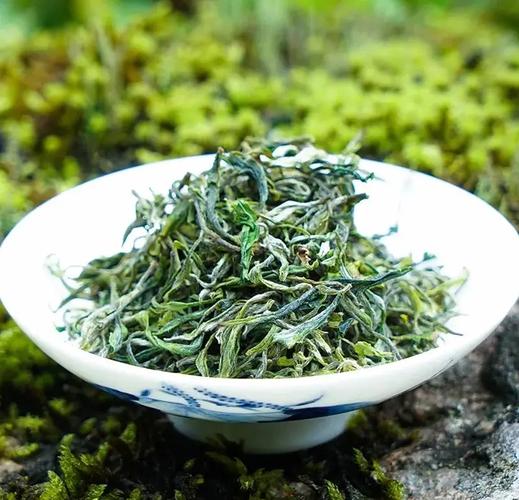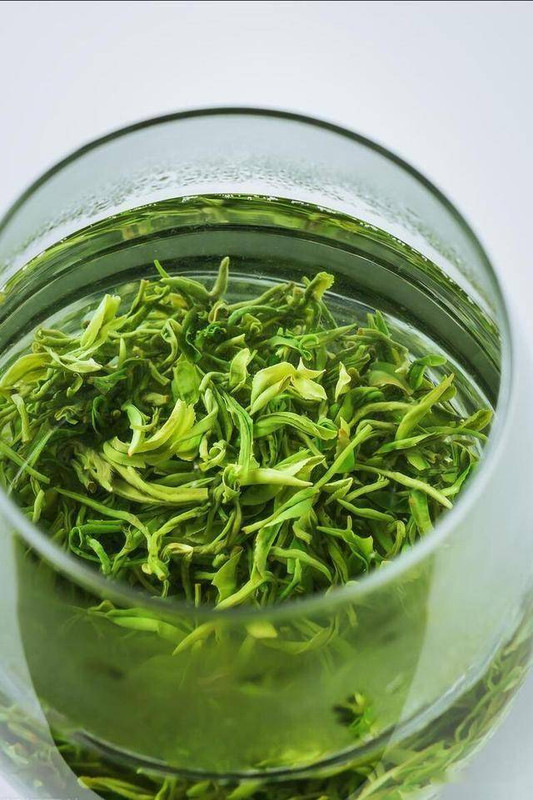Nestled in the mist-shrouded valleys of Xiaokeng Village, Shitai County, Anhui Province, 霄坑绿茶 (Xiāokēng Lǜchá) emerges as one of China’s most intriguing green teas. Celebrated for its wilderness-inspired character and centuries-old craftsmanship, this tea embodies the untamed beauty of its birthplace—a region where terraced tea gardens cling to steep slopes and ancient forests guard secrets of the past. Let us embark on a journey to uncover its history, terrain, and timeless allure.

Origins & Legendary Heritage
Xiaokeng Green Tea’s story begins in the Ming Dynasty (14th–17th centuries), when local tea masters began cultivating wild tea trees growing amidst Xiaokeng’s virgin forests. Legend has it that monks from nearby Jiuhua Mountain—a sacred Buddhist site—prized this tea for its ability to enhance meditation, dubbing it the “tea of enlightenment.” Today, it remains a cherished local specialty, its production methods largely unchanged by time.
Terroir: The Wild Heart of Anhui
The tea gardens of Xiaokeng occupy a UNESCO-designated biosphere reserve, where:
- Altitude: 400–800 meters above sea level, shrouded in year-round fog.
- Soil: Volcanic loam enriched by decaying leaves and mineral-rich bedrock.
- Climate: Frequent rainfall, cool temperatures, and sharp day-night temperature shifts.
These conditions, combined with minimal human intervention, result in leaves with a robust, earthy character.
Craftsmanship: The Art of Wildness
The production of Xiaokeng Green Tea is a rustic yet precise craft:
- Plucking: Only the mature leaf and stem are harvested in late spring, ensuring boldness.
- Withering: Leaves are spread on bamboo mats in shaded huts to soften.
- Fixation (Killing Green): Pan-fried in woks over wood fire at 180–200°C, imparting a smoky aroma.
- Rolling: Leaves are twisted by hand into loose curls, preserving their wild essence.
- Drying: Final roasting over charcoal to enhance durability and lock in flavor.
Aesthetic & Sensory Profile
When steeped, Xiaokeng Green Tea reveals its rugged charm:
- Appearance: Leaves unfurl into dark emerald strips with occasional red edges.
- Liquor: Amber-green hue, reminiscent of mountain streams.
- Aroma: Earthy notes of moss and pine, with hints of roasted chestnut.
- Taste: Bold, vegetal freshness transitions to a lingering sweetness akin to wild honey.
Brewing Rituals
To honor its wildness:
- Water: Use soft, spring water heated to 85–90°C (185–194°F).
- Ratio: 4 grams of tea per 150 ml (1:37 tea-to-water ratio).
- Vessel: Clay teapot or porcelain gaiwan to mellow its robustness.
- Infusion: First steep for 2–3 minutes; extend subsequent brews by 1 minute (up to 3 infusions).
Authenticity & Grading
Genuine Xiaokeng Green Tea is distinguished by:
- Appearance: Irregular, twisted leaves with red stems.
- Aroma: Earthy, pine-like fragrance with subtle smokiness.
- Liquor: Clear amber-green hue.
- Infused Leaves: Dark emerald-green, slightly brittle.
Graded into Wild, Premium, and Standard tiers based on leaf uniformity, pluck standard, and craftsmanship. Wild-grade tea, harvested from uncultivated trees, commands 150–300 per 100 grams, while Standard grades range from 60–150.
Healthful Alchemy
Rich in polyphenols, catechins, and selenium, Xiaokeng Green Tea offers:
- Antioxidant Power: Combats free radicals linked to aging and cancer.
- Cardiovascular Support: Lowers cholesterol and improves blood circulation.
- Detoxification: Aids in eliminating heavy metals from the body.
- Mental Clarity: Natural caffeine and L-theanine promote alertness without jitters.
Cultural Resonance
Beyond its cup, Xiaokeng Green Tea is woven into local folklore and survival stories. Villagers have long relied on its medicinal properties to treat colds and fatigue, while poets have likened its aroma to “the breath of ancient forests.” Today, it remains a symbol of Anhui’s untamed tea heritage, a bridge between wilderness and civilization.
In every sip of Xiaokeng Green Tea, one encounters not just a tea, but the spirit of China’s sacred mountains—a tribute to the harmony between humanity and the wild.



